International Economics - Balance of Trade Vs Balance of Payments | 12th Economics : Chapter 7 : International Economics
Chapter: 12th Economics : Chapter 7 : International Economics
Balance of Trade Vs Balance of Payments
Balance of Trade Vs Balance of Payments
Balance of Trade and Balance of Payments are two different
concepts in the subject of international trade.
1. Balance of Trade (BOT)
Balance of Trade (BOT) refers to the total value of a country’s
exports of commodities and total value of imports of commodities. Only export
and import of commodities are included in the statement of Balance of Trade of
a country. Movements of goods (export and imports of commodities) are also
known as ‘visible trade’, because the movement of commodities between
countries can be seen by eyes and felt by hands and can be verified physically
by custom authorities of a country.
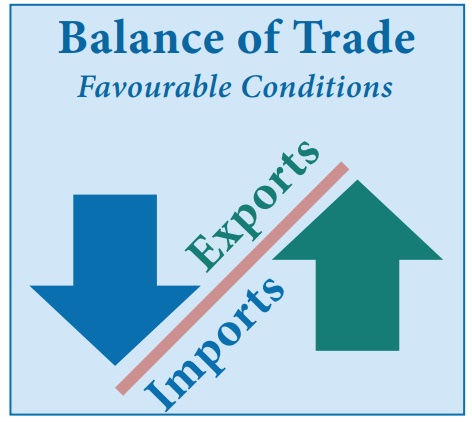
Favourable BOT
When the total value of commodity exports of a country exceeds the
total value of commodity imports of that country, it is said that the country
has a ‘favourable’ balance of trade.
Unfavourable BOT
If total value of commodity exports of a country is less than the
total value of commodity imports of that country, that country is said to have
an ‘unfavourable’ balance of trade.
2. Balance of Payments (BOP)
BoP is a systematic record of a country’s economic and financial
transactions with the rest of the world over a period of time.
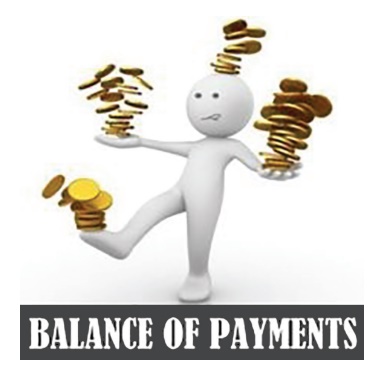
When a payment is received from a foreign country, it is a credit
transaction while a payment to a foreign country is a debit transaction. The
principal items shown on the credit side are exports of goods and
services, transfer receipts in the form of gift etc., from foreigners,
borrowing from abroad, foreign direct investment and official sale of reserve
assets including gold to foreign countries and international agencies.
The principal items on the debit side include imports of
goods and services, transfer payments to foreigners, lending to foreign countries,
investments by residents in foreign countries and official purchase of reserve
assets or gold from foreign countries and international agencies.
3. Components of BOPs
The credit and debit items are shown vertically in the BOP account
of a country. Horizontally, they are divided into three categories, i.e.
a) The current account,
b) The capital account and
c) The official settlements account or official reserve assets
account.
a) The Current Account: It includes all international trade
transactions of goods and services, international service transactions (i.e.
tourism, transportation and royalty fees) and international unilateral
transfers (i.e. gifts and foreign aid).
b) The Capital Account: Financial transactions consisting of
direct investment and purchases of interest-bearing financial instruments,
non-interest bearing demand deposits and gold fall under the capital account.
c) The Official Reserve Assets Account: Official reserve
transactions consist of movements of international reserves by governments and
official agencies to accommodate imbalances arising from the current and
capital accounts.
The official reserve assets of a country include its gold stock,
holdings of its convertible foreign currencies and Special Drawing Rights
(SDRs) and it1s net position in the International Monetary Fund (IMF).
Balance of Payment (BOP) Account Chart
Credit (Receipts) – Debit (Payments) = Balance [Deficit
(-) , Surplus (+)]
Deficit if Debit > Credit
4. Balance of Payments Disequilibrium
The BoP is said to be balanced when the receipts (R) and payments (P) are just equal, i.e,
R / P =1.
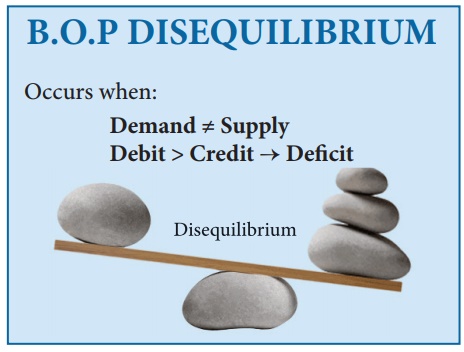
Favourable BoP
When receipts exceed payments, the BoP is said to be favourable.
That is,
R / P > 1.
Unfavourable BOP
When receipts are less than payments, the BoP is said to be
unfavourable or adverse.That is
R / P < 1.
5. Types BOP Disequilibrium:
There are three main types of BOP Disequilibrium, which are
discussed below.
(a) Cyclical Disequilibrium,
(b) Secular Disequilibrium,
(c) Structural Disequilibrium.
a) Cyclical Disequilibrium: Cyclical disequilibrium occurs because of
two reasons. First, two countries may be passing through different phases of
business cycle. Secondly, the elasticities of demand may differ between
countries.
b) Secular Disequilibrium: The secular or long-run disequilibrium in
BOP occurs because of long-run and deep seated changes in an economy as it
advances from one stage of growth to another. In the initial stages of
development, domestic investment exceeds domestic savings and imports exceed
exports, as it happens in India since 1951.
c) Structural Disequilibrium: Structural changes in the economy may
also cause balance of payments disequilibrium. Such structural changes include
development of alternative sources of supply, development of better
substitutes, exhaustion of productive resources or changes in transport routes
and costs.
6. Causes for BoP Disequilibrium
The following are the major causes producing disequilibrium in the
balance of payments of a country.
1. Cyclical Fluctuation: Cyclical disequilibrium in different countries
is caused by their cyclical fluctuations, their phases and
magnitude. World trade shrinks
during depression while trade flourishes during prosperity
2. Structural Changes: Structural disequilibrium is caused by the
structural changes brought by huge development and investment programmes in the
developing economies.Such economies may have high propensity to import for want
of capital for rapid industrialization, while export may not be boosted up to
that extent.
3. Development Expenditure: Development disequilibrium is caused by rapid
economic development which results in
income and price
effects. The less developed countries in the early stage
of development are not self
sufficient. Income, savings
and investment are abysmally low. They depend upon developed countries for
import of commodities,
capital and technology. Export
potential is low and import intensity is high. So the LDCs suffer from adverse
BoP.
4. Consumerism: Balance of payments position of a country
is adversely affected by a huge increase in consumption. This increases the
need for imports and decreases the capacity to export.
5. Demonstration Effect: Deficit in the balance of
payments of developing countries is also caused by demonstration effect which
influences the people in UDCs to imitate western styled goods. This will raise
the propensity to import causing adverse balance of payments. This is good for
the developed countries.
6. Borrowing: International borrowing and investment may cause a deficit
in the balance of payments. When the international borrowing is heavy, a
country’s balance of payments will be adverse since it repays loans with
interest. Servicing of debt is a huge burden. That is why the UDCs are forced
to borrow more.
7. Technological Backwardness: Due to technological backwardness, the
people (Indians) are unable to use the energy (Solar) available with them. As a
result they import huge petroleum products from foreign countries, increasing
the trade deficit.
8. Global Politics: The rich countries (Eg. USA) need to sell
their weapons to promote their economy and generate employment. Hence, wars
between countries (for example Iran and Irag, Pakistan and India) are
stimulated In order to win the wars, the poor countries are forced to buy the
weapons from weapon – rich countries, using their export earnings and creating
trade deficit. Thus UDCs are trapped forever.
7. Measures to Correct BOP Disequilibrium
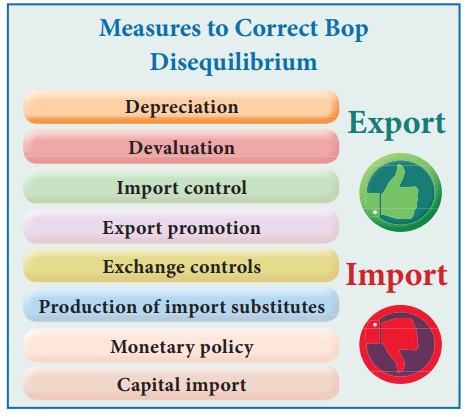
There are a number of measures available for correcting the
balance of payments disequilibrium. They are divided into two baord groups,
namely,automatic correction and (ii) deliberate measures.
I. Automatic Correction
If the market forces of demand and supply are allowed to play
freely, equilibrium will be automatically restored in course of time. Under the
free exchange rate system, the automatic adjustments of the balance of payments
can take place through changes in the variables like price, interest, income
and capital flows.
1. Price Adjustments
As a result of foreign exchange outflow from a deficit country to
a surplus country, there will be a fall in the money supply in the deficit
country and increase in the money supply in the surplus country. This will
result in rise in the price in the surplus country which will encourage imports
and discourage exports. Fall in prices in the deficit country will encourage
exports and discourage imports, leading to restoration of BoP equilibrium.
2. Interest Rate Adjustments
The contraction or expansion of money supply resulting from the
BoP deficit or surplus leads to a rise or fall in the interest rates. A rise in
interest rate in the deficit country will encourage investors to withdraw their
funds from abroad and invest in their home country. The opposite happens in the
surplus country.
3. Income Adjustments
A nation with payments surplus will experience rising income which
will increase imports and thereafter equilibrium is restored in Balance of
Payments.
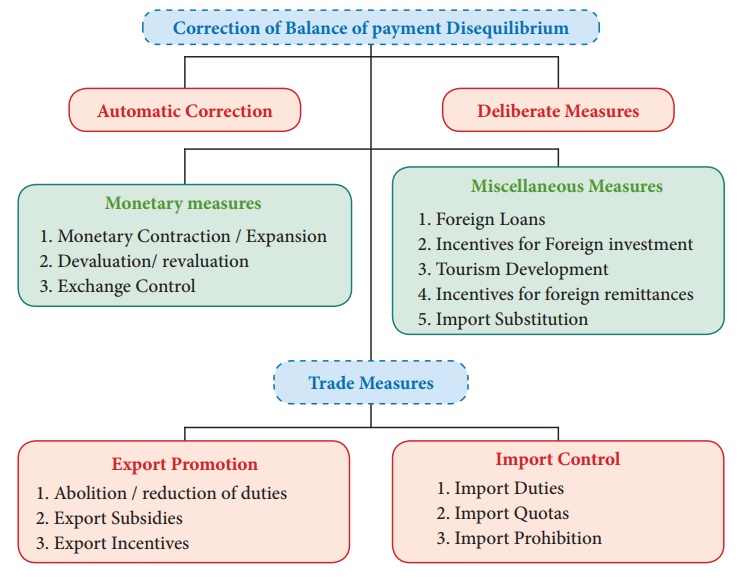
4. Capital Flows
Changes in the interest rate consequent to the BoP disequilibrium
will encourage capital flows from the surplus nations to deficit nations
helping restoration of the BoP equilibrium.
II. Deliberate Measures
The deliberate measures may be broadly grouped into (a) monetary
measures (b) trade measures and (c) miscellaneous measures.
a. Monetary Measures
1. Monetary Contraction
High domestic price level is responsible for high imports and low
exports. In order to control inflation, the central monetary authority controls
credit. As a result, the prices come down and exports increase. This will help
to correct adverse BoP. However, if credit is controlled, investment will
decline, production will go down, prices will increase. This is the cause of
confusion between government and RBI in India in 2010s.
2. Devaluation
Devaluation means deliberate reduction of the official rate at
which domestic currency is exchanged for another currency. In other words,
devaluation refers to a reduction in the external value of a currency in the
terms of other currencies. For instance, instead of 70 ₹ per US$, making ₹ 80
per US$.
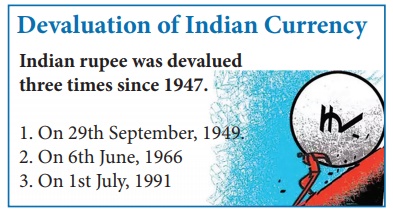
A country with fundamental disequilibrium in the balance of
payments may devalue its currency in order to stimulate its exports and
discourage imports to correct the disequilibrium. Devaluation makes exports
cheaper and imports dearer. That means making Indian good cheaper for
foreigners, and foreign goods costlier for Indians.
3. Exchange Control
Exchange control means the state intervention in the forex market.
It is a popular method employed to influence the balance of payments position
of a country. Under exchange control, the government or central bank assumes
complete control over the foreign exchange reserves and earning of the country.
The recipients of foreign exchange, like exporters, are required to surrender
foreign exchange to the government / central bank in exchange for domestic
currency. By virtue of its control over the use of foreign exchange, the
government can control imports. Does it happen in India? Too much of imports
control would invite more and more smuggled goods. Smuggling of gold into
Indian airports regularly happens, as per the reports in the media.
III. Trade Measures
Trade measures include measures to promote exports and to reduce
imports.
1. Export Promotion
Exports may be encouraged by i).reducing or abolishing export
duties, ii). providing export subsidy, iii).encouraging export production by
giving monetary, fiscal, physical and institutional incentives. (Then local
people and domestic industries would suffer)
2. Import Control
Imports may be controlled by i).imposing or enhancing import
duties, ii).restricting imports through import quotas, iii).licensing and even
prohibiting altogether the import of certain non essential items. But this
would encourage smuggling.
IV. Miscellaneous Measures
In addition to the measures mentioned above, there are a number of
other measures that can help make the balance of payments position more
favourable, like i). foreign loans, ii).encouraging foreign investment in the
home country, iii).development of tourism to attract foreign tourists,
iv).providing incentives to enhance inward remittances and v). import
substitution.
Related Topics